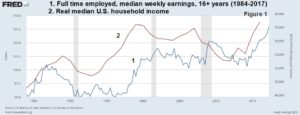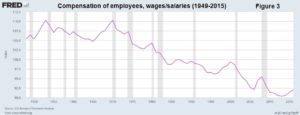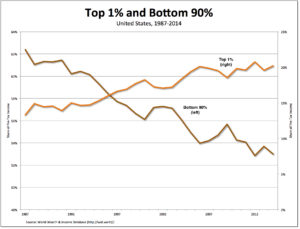Inequality and immiseration in the U.S. – David Ruccio
It’s clear that, for decades now, U.S. workers have been falling further and further behind. And there’s simply no justification for this sorry state of affairs – nothing that can rationalize or excuse the growing gap between the majority of people who work for a living and the tiny group at the top. But that doesn’t stop mainstream economists from trying. Look, they say, U.S. workers are clearly better off than they were before.

Both real weekly earnings (the lowerine in the chart, Fig 1) and the median household income (the upper line) are higher than they were thirty years ago.
There’s no denying that, on average, the absolute level of worker pay and household income has gone up. That’s proof, mainstream economists argue, that workers are enjoying the fruits of their labor.
The problem is that the increase in workers’ wages (Fig 2, lower line – the same as in the previous chart) pales in comparison to the rise in labor productivity (upper line in Fig 2): since 1987, real wages have increased by only 8%, while productivity has grown by 75%. In other words, U.S. workers have been producing more and more but getting only a tiny share of that increase.
It should come as no surprise, then, that the wage share of national income (Fig 3) has fallen precipitously – by 8% since 1987 and by 16.5% since 1970.
U.S. workers are in fact experiencing a relative immiseration compared to their employers, who are able to capture the additional amount their workers are producing in the form of increased profits. Moreover, U.S. employers have every interest – and more and more means at their disposal – to continue to widen the gap between themselves and their workers. Not surprisingly, the relative immiseration of U.S. workers shows up in growing inequality – with the share of income captured by the top 1% increasing and the share going to the bottom 90% falling (see Fig 4).
Each is a consequence of the other. U.S. workers are getting relatively less of what they produce, which means more is available to distribute to those at the top of the distribution of income. That’s what mainstream economists don’t understand: that workers may be worse off even as their wages and incomes rise. That problem flies in the face of every attempt to celebrate the existing order by claiming “just deserts.”
There’s nothing just about the relative immiseration and growing inequality faced by U.S. workers. And nothing that can’t be changed by imagining and creating a radically different set of economic institutions.
Comment From peterblogdanovich
Actually both firms and labor are losing out to the financial sector. Just before the GFC finance reached 40% of private sector profits. This same number was about 5% after WWII. Executive bonuses in non financial firms are a tiny fraction of labor’s share of output. Pull on this thread and you will be appalled at what has happened to both labor and non financial firms.

[su_divider top=”no” size=”0″ margin=”20″]

[su_divider top=”no” size=”0″ margin=”20″]

[su_divider top=”no” size=”0″ margin=”20″]Source: Real World Econ Rev, 9 Oct. 2017; https://rwer.wordpress.com/2017/10/09/inequality-and-immiseration-4-graphs/



























